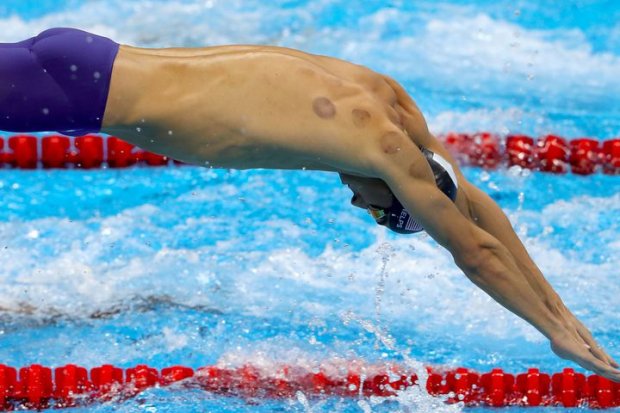Olympian pictured with “cupping” traces on their backs

A number of Olympians – including the most decorated Olympic athlete of all time, Michael Phelps – have been photographed with large red circles on their skin.
The mark of an Olympic athlete, at least at Rio 2016, seems to be a scattering of perfectly round bruises. Swimmers and gymnasts, particularly from Team USA, are among those seen sporting the mysterious dots. No, not paintballing misadventures or love bites – they are the result of a practice known as “cupping”; an ancient therapy where heated cups are placed on the skin.
So how is ‘cupping’ done?
The technique, which is a form of acupuncture, is done by lighting flammable liquid in a glass cup. Once the flame goes out, the drop in temperature creates suction which sticks the cups to the body. The suction pulls the skin away from the body and promotes blood flow – and leaves those red spots, which typically last for three or four days.
Why are some Olympians using it?
Athletes say they are using it to ease aches and pains, and to help with recovery from the physical toil of constant training and competing. You need to install Flash Player to play this content.
Media captionWatch Jacky Long demonstrate how ‘cupping’ is done
There are plenty of other recovery techniques competitors use – including sports massage, sauna, ice baths and compression garments – but US gymnast Alex Naddour told USA Today that cupping was “better than any money I’ve spent on anything else”.
“That’s been the secret that I have had through this year that keeps me healthy,” Naddour told the paper, adding that it had saved him from “a lot of pain”.
His team captain Chris Brooks added that many on the squad had started “do-it-yourself” cupping, with cups that can be suctioned with a pump rather than with a flame.
“You’re like, ‘OK, I’m sore here,'” said Brooks. “Throw a cup on, and your roommate will help you or you can do it yourself.”
The marks visible on Michael Phelps as he competed in the men’s 4x100m freestyle relay on Sunday had people on social media speculating what they might be, with some guessing he might have been playing paintball or attacked by a giant octopus.
Does it actually work?
Practitioners claim cupping helps with a huge variety of ailments from muscle problems, pain relief, arthritis, insomnia, fertility issues, and cellulite. Mr Long, who has practised cupping for 20 years, says the idea is to help the flow of energy – known as traditional Chinese medicine as “qi” – around the body, and rebalance its equilibrium – “ying and yang”. The darker the mark left by the cup, he says, the poorer the blood circulation is in that part of the body.
While there have “certainly been satisfied customers for 3,000 years”, Professor Edzard Ernst from the department of complementary medicine at the University of Exeter previously told the BBC it was not a proven medical treatment. He insisted it was a relatively safe practice, but added: “There is no evidence for its efficacy. It has not been submitted to clinical trials.”
Pharmacologist Prof David Colquhoun, from University College London, dismissed cupping as “hocus pocus” and told the BBC: “It’s just pulling up a bit of skin, it is not going to affect the muscle to any noticeable extent.
“And taken to extreme, it can cause harm, it usually doesn’t, it’s usually just a – what [British physician] Ben Goldacre would call – a voluntary tax on the gullible.”
Image copyright Wellcome Library
Image caption An illustration from a medical textbook “Exercitationes practicae” published in 1694 shows a man undergoing cupping on his bottom
Who else does this?
It’s not only athletes who use cupping. The practice has long proved popular among A-listers in search of the next best therapy.
Justin Bieber, Victoria Beckham and Jennifer Aniston have all been photographed with what look like cupping marks. And Nicole Richie made her dad, singer Lionel Richie try it – although pictures suggest he might not entirely have enjoyed it.
Cupping has also become an increasingly available and popular treatment in beauty parlours and spas, as well as traditional Chinese medicine shops where it is commonly on offer.
Doesn’t it hurt?
The British Acupuncture Council (BAcC) says cupping is not painful, and the red marks left on the skin are caused by blood being drawn to the surface and small capillaries rupturing.
On the other hand, swimmer Michael Phelps was filmed wincing as he underwent the technique in a recent advert, and other Olympians have posted pictures of what look like painful cupping sessions on social media.
US swimmer Natalie Coughlin posted a picture of cups suctioned to her chest – with the words: “Laughing because it hurts so bad” – and a painful looking picture of the aftermath of the therapy.
Belarusian swimmer Pavel Sankovich also posted a photo of his legs covered in a dozen of the little domes.
The BAcC warns that on “rare occasions” the hot cups can cause mild burns. It has published rules of practice for cupping, and advises people only to visit properly-trained practitioners who are accredited members of their organisation.
So what does it feel like?
There’s only one way to find that out – try it.
In the name of journalism, BBC News paid a visit to traditional Chinese medicine practitioner Jackie Long, in central London, who himself undergoes cupping once a week.
The main sensation is one of tightness, pressure and warmth where the cup is placed – slightly uncomfortable, but not painful.
The sight of the skin being sucked upwards in a dome into the glass may be a little alarming for a novice – but it looks much worse than it feels.
How did it start?
Cupping originated in China some 3,000 years ago, Mr Long says, but also became popular in Egypt, the Middle East and around the globe.
Before glass cups, cups made of bamboo were used to the same effect. The technique is known in Mandarin Chinese as “huo guan”, which means “fire cupping”, and is popular in China with older generations, he says.
There is also a technique known as “wet cupping”, which is done in both China and some parts of the Muslim world where it is known as “hijama”. It involves making a small cut in the skin before the cup is placed. The suction draws out a small quantity of blood.
Mr Long says many people in Western countries find this “difficult to accept”, but explains that it is seen in Chinese medicine as a type of detox and is very popular.
How to submit an Op-Ed: Libyan Express accepts opinion articles on a wide range of topics. Submissions may be sent to oped@libyanexpress.com. Please include ‘Op-Ed’ in the subject line.
- Tripoli forum calls for prioritising reconciliation efforts - January 03, 2025
- China’s reported Libya dealings raise regional power questions - January 02, 2025
- Disease control center confirms no human rabies cases in Libya - January 02, 2025


